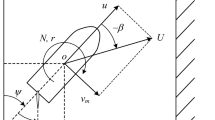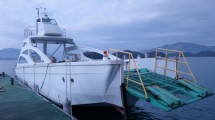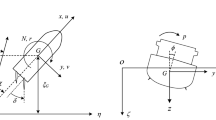Abstract
Currently, accelerated research on automation is involved in most fields associated with vehicle manufacturing. In the area of autonomous operation of marine vehicles, automatic berthing remains a problem due to the nonlinearity of the low-speed maneuvering model, poor control of the vessel at low speed, and collision with berth danger. A previous study on off-line automatic berthing reveals frequent switching of the propeller revolution direction, which is impractical and must be prevented in case of a diesel engine. In this study, to overcome this problem, a new variable for the time to switch the propeller revolution direction is introduced and optimized. Also, we establish a more robust off-line control method for optimizing the required time and the final ship attitude by enhancing the objective function. Since the method provided here is still an off-line control method, its applicability to on-line control must consider the external force uncertainty and modeling error. The set of the optimal control input and trajectory obtained in this study, however, are applicable as an initial candidate for on-line predictive control modeling. Furthermore, the trajectory can serve as the desired path in a path-tracking problem.






Similar content being viewed by others
References
https://www.unmanned-ship.org/munin/. Accessed 25 June 2018
https://www.rolls-royce.com/~/media/Files/R/Rolls-Royce/documents/customers/marine/ship-intel/rr-ship-intel-aawa-8pg.pdf. Accessed 25 June 2018
Maki A, Sakamoto N, Akimoto Y, Nishikawa H, Umeda N (2020) Application of optimal control theory based on the evolution strategy (CMA-ES) to automatic berthing. J Mar Sci Technol 25:221–233
Ohtsuka T (2004) A continuation/GMRES method for fast computation of nonlinear receding horizon control. Automatica 40(4):563–574
Shouji K, Ohtsu K (1992) A study on the optimization of ship maneuvering by optimal control theory (1st report). J Soc Nav Arch Jpn 172:365–373 (in Japanese)
Akimoto Y, Hansen N (2020) Diagonal acceleration for covariance matrix adaptation evolution strategies. Evol Comput 28:405–435
Hansen N, Auger A (2014) Principled design of continuous stochastic search: from theory to practice. In: Borenstein Y, Moraglio A (eds) Theory and principled methods for designing metaheustics. Springer, Berlin, pp 145–180
Yasukawa H, Yoshimura Y (2015) Introduction of MMG standard method for ship maneuvering predictions. J Mar Sci Technol 20:37–52
Yoshimura Y, Nakao I, Ishibashi A (2008) Unified mathematical model for ocean and harbor maneuvering. Proc Int Conf Mar Simul Ship Maneuverabil 2009:116–124
Final report and recommendations to the 23rd ITTC: the specialist committee on Esso Osaka (2002) In: The Proceedings of the 23rd ITTC conference
Ueda N (1985) On the maneuvering motion of a vessel during backing. Master thesis, Osaka university (in Japanese)
Hachii T (2004) The prediction of maneuvering motion on ships with low speed using standard MMG model. Master thesis, Osaka university (in Japanese)
Koyama T, Jin Y, Jin KH (1987) A systematic study on automatic berthing control (1st report). J Soc Nav Arch Jpn 162:201–210 (in Japanese)
Sakamoto N, Akimoto Y (2017) Improvement to the box constraint handling method for the CMA-ES and its generalization to linear constraints. Trans Jpn Soc Evol Comput 8(2):23–35 (in Japanese)
Sakamoto N, Akimoto Y (2017) Modified box constraint handling for the covariance matrix adaptation evolution strategy, In: Genetic and evolutionary computation conference, Berlin, Germany, 15–19 July 2017, Companion material proceedings, pp 183–184
Auger A, Hansen N (2005) A restart CMA evolution strategy with increasing population size. In: Proc. of the 2005 IEEE congress on evolutionary computation, pp 1769–76
Wakita K, Maki A, Shimoji T, Umeda N, Dimas MR, Akimoto Y (2020) On system identification for low-speed maneuvering model (1st report: black-box approach). In: Conference proceedings, the Japan Society of Naval Architects and Ocean Engineers, Spring Meeting (in Japanese)
Nishikawa H, Maki A, Umeda N, Dimas MR, Shimoji T, Akimoto Y (2020) On system identification for low-speed maneuvering model by using CMA-ES (3rd report). In: Conference proceedings, the Japan Society of Naval Architects and Ocean Engineers, Spring Meeting (in Japanese)
Miyauchi Y, Maki A, Umeda N, Dimas MR, Shimoji T, Akimoto Y (2020) On system identification for low-speed maneuvering model by using CMA-ES (3rd Report). In: Conference proceedings, the Japan Society of Naval Architects and Ocean Engineers, Autumn Meeting
Acknowledgements
This study was supported by a Grant-in-Aid for Scientific Research from the Japan Society for Promotion of Science (JSPS KAKENHI Grant # 19K04858). The study also received assistance from JFY2018 Fundamental Research Developing Association for Shipbuilding and Offshore (REDAS) in Japan. The authors are thankful to Enago (www.enago.jp) for reviewing the English language.
Author information
Authors and Affiliations
Corresponding author
Additional information
Publisher's Note
Springer Nature remains neutral with regard to jurisdictional claims in published maps and institutional affiliations.
About this article
Cite this article
Maki, A., Akimoto, Y. & Naoya, U. Application of optimal control theory based on the evolution strategy (CMA-ES) to automatic berthing (part: 2). J Mar Sci Technol 26, 835–845 (2021). https://doi.org/10.1007/s00773-020-00774-x
Received:
Accepted:
Published:
Issue Date:
DOI: https://doi.org/10.1007/s00773-020-00774-x




